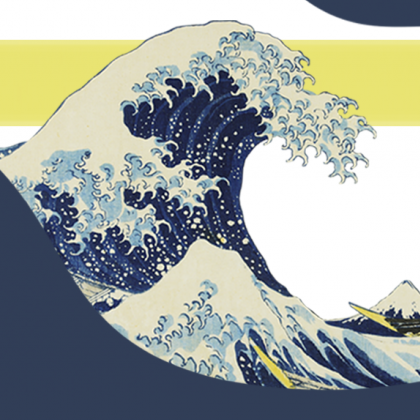The Great Wave - The importance of water in Japanese culture
The Great Wave - The importance of water in Japanese culture
The Edoardo Chiossone Oriental Art Museum reopens to the public with the exhibition La Grande Onda. The importance of water in Japanese culture. The exhibition, which can be visited until 24th September, was curated by Aurora Canepari and sponsored by Iren. The exhibition received the patronage of the Consulate of Japan in Milan.
Japan, surrounded by the sea on all sides and with a humid climate and abundant rainfall, has developed a strong and ambivalent relationship with water: a familiar and invigorating presence when it irrigates the rice fields and gives fruitful fishing, but also a terrible threat, when it manifests itself with the force of the ocean or floods. In art, water has been depicted in a variety of subjects since ancient times, including famous places, landscapes and decorative motifs in the applied arts. Especially in woodblock printing at the end of the 19th century, water was the protagonist of a wide range of works in which the vibrant blue of the Prussian blue pigment, which was trendy at the time, could be used and transmitted.
The most famous example is Hokusai's Great Wave, a work that surpassed any other existing image in terms of number of reproductions and iconicity. The itinerary of the temporary exhibition is structured around this famous print, of which the Chiossone Museum preserves a magnificent example. From landscapes with seas, lakes, rivers and waterfalls to symbolic meanings in Buddhism and Shinto, in Japanese culture the theme of water is found in multiple forms and with different outcomes. On display, over 60 aquatic-themed ukiyoe prints from the Chiossone collection, including the famous landscapes of Hokusai and Hiroshige, the city life scenes of Kunisada and Yoshitoshi and the fantastic subjects of Kuniyoshi.
In dialogue with the masterpieces of the great masters of the Edo period (1603-1868), two works of contemporary art by the Japanese artist Oki Izumi are exhibited. These pieces, dealing with the Genoese collection, questioned the meanings of water and gave it form in his glass sculptures.
The E. Chiossone Museum
The Chiossone Museum boasts the largest and most important collection of Japanese art in Italy, gathered by the Genoese artist and engraver Edoardo Chiossone during his long period in Japan at the end of the 19th century. In an elevated position and facing the sea, inside the historic park of Villetta Di Negro, the Museum is surrounded by greenery and inserted in the panoramic and botanical itineraries. That of Chiossone was the first collection of Italian oriental art to be opened to the public, in 1905, in the original site at the Ligustica Academy of Fine Arts, while since 1971 it has been exhibited in the current building, specially designed by the Genoese architect Mario Labò in the 50s.
Timetables
From Tuesday to Friday
9 AM - 7 PM
Saturday and Sunday
10 AM - 7.30 PM (last entry at 7 PM)
Tickets
Full price €5
Reduced 3
The exhibition “The Great Wave. The Importance of Water in Japanese Culture” is included in the admission ticket.
More informations
Useful info

Log in to be able to add content to your favourites!



